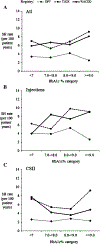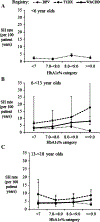Severe hypoglycemia rates are not associated with HbA1c: a cross-sectional analysis of 3 contemporary pediatric diabetes registry databases
- PMID: 27878914
- PMCID: PMC7162500
- DOI: 10.1111/pedi.12477
Severe hypoglycemia rates are not associated with HbA1c: a cross-sectional analysis of 3 contemporary pediatric diabetes registry databases
Abstract
Objective: To examine the association between glycated hemoglobin (HbA1c) and severe hypoglycemia rates in patients with type 1 diabetes receiving usual care, by analysing data from the US Type 1 Diabetes Exchange (T1DX), German/Austrian Diabetes Patienten Verlaufsdokumenation (DPV), and Western Australian Children Diabetes Database (WACDD) diabetes registries.
Methods: Data for patients with type 1 diabetes, aged <18 years with a minimum duration of diabetes of 2 years, were extracted from each registry for a 12-month observation period between 2011 and 2012 (7,102 T1DX, 18,887 DPV, and 865 WACDD). Rates of severe hypoglycemia (self-reported loss of consciousness/convulsion) were estimated per 100 patient-years and analyzed by HbA1c, source registry, treatment regimen, and age group.
Results: Overall, the severe hypoglycemia rate per 100 patient years was 7.1, 3.3, and 6.7 in T1DX, DPV, and WACDD patients, respectively. Lower HbA1c was not associated with an increased rate of severe hypoglycemia when examined by source registry, treatment regimen, or age group.
Conclusion: An inverse relationship between mean HbA1c and risk of severe hypoglycemia was not observed in this study of 3, independent cohorts of children and adolescents with type 1 diabetes. Investigation in other large, longitudinal cohorts is recommended to further characterize the contemporary relationship between glycemic control and risk of severe hypoglycemia rates in pediatric patients with type 1 diabetes.
Keywords: adolescent; child; diabetes mellitus; hypoglycemia; registries; type 1.
© 2016 John Wiley & Sons A/S. Published by John Wiley & Sons Ltd.
Conflict of interest statement
Conflict of interest
A.H., D.M.M, J.M.H., K.M.M., E.A.D., S.E.H., T.W.J., R.W.B., R.W.H. have no conflicts of interest related to this publication to declare. D.M.M. is on the advisory board for Insulet, consults for Abbott, and his institution has received research funding from Medtronic, Dexcom, and Roche. T.W.J. has received honoraria for speaking and advisory board membership from Eli-Lilly, Novo-Nordisk, Sanofi, and Medtronic. R.W.B. institution receives consulting and/or research funding from Dexcom, Bigfoot, Tandem, and Animas.
Figures


References
-
- Cryer PE. Glycaemic goals in diabetes: trade-off between glycaemic control and iatrogenic hypoglycemia. Diabetes. 2014;63:2188–2195. - PubMed
-
- The Diabetes Control and Complications Trial Research Group. The effect of intensive treatment of diabetes on the development and progression of long-term complications in insulin-dependent diabetes mellitus. N Engl J Med. 1993;329:977–986. - PubMed
-
- The Diabetes Control and Complications Trial Research Group. Hypoglycemia in the diabetes control and complications trial. Diabetes. 1997;46:271–286. - PubMed
-
- Davis E, Keating B, Byrne G, Russell M, Jones T. Hypoglycemia: incidence and clinical predictors in a large population-based sample of children and adolescents with IDDM. Diabetes Care. 1997;20:22–25. - PubMed
-
- Johnson SR, Cooper MN, Davis EA, Jones TW. Hypoglycemia, fear of hypoglycemia and quality of life in children with type 1 diabetes and their parents. Diabet Med. 2013;30:1126–1131. - PubMed
MeSH terms
Substances
Grants and funding
LinkOut - more resources
Full Text Sources
Other Literature Sources
Medical

